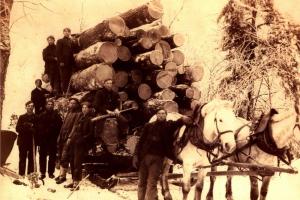
Like most other northern Wisconsin areas, railroad workers, loggers, and early settlers came to the Cassian area, because of the huge stands of pine that had been pretty much cut by the early 1900's, leaving vast expanses of cutover and burned over land. The railroad workers came to build the Chicago, Milwaukee and St. Paul Railway through the town. After the logs were cut, they were skidded by oxen and horses with sleighs, as above, often to narrow-gage railways.
This photo of a loaded logging sleigh, was furnished by the Busche Family. The exact site is unknown. There appears to be a heavy load of White Pine logs, typically harvested in huge quanities from the Cassian and surrounding area. in the late 1880's and into the 1890's most logs were skidded to lake or river banks and floated to the mills in Merrill, later both pine and hardwoods were hauled out on narrow gauge railroad spurs, which crisscrossed the area until about 1912. Remnants of these spurs can still be seen after 100+years, and many of todays roads, were built on these early rail beds..
A renovated logging sleigh, from this era, similar to the one in this photo, can be seen sitting on the West side of the Cassian Town Hall and Fire Station on Church Road.
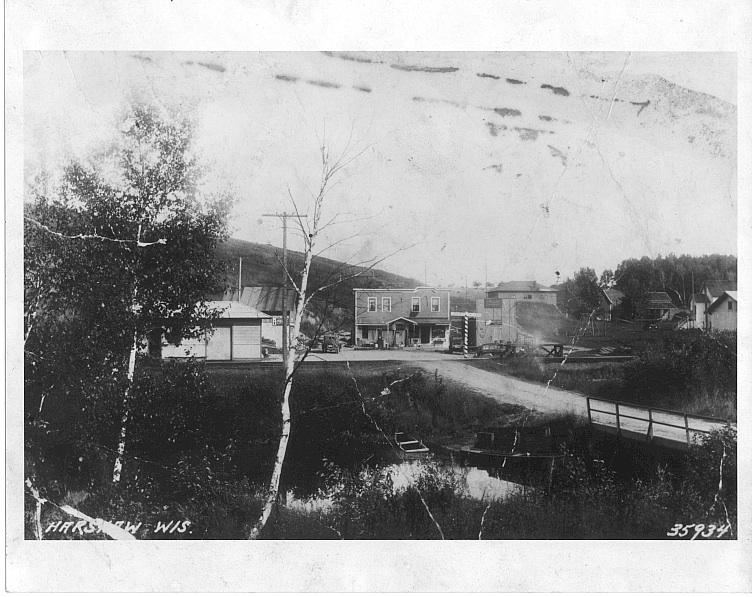
A Photo of Harshaw during the 1920's. From left is the Bearskin Creek, the Railway Depot, ice house, Harshaw Store, owned by Barzy Winnie and Wlm. Stock, and it's warehouse. Above that is Winnie's Hall, the location of many town events and meetings. It sat above an in-ground potato storage facility for the Winnie Farm. To the right of that can be seen the Harshaw Schoolhouse, the Barzy Winnie barn and farmhouse, and the potato warehouse owned by Leonard Hamilton along the Chicago,Milwaukee, St. Paul Railway. Harrison McNown purchased and operated the store and post office from 1927, until the late 1950's. Almost every one in town owed him money for goods received during the depression.
Sadly this structure burned down about 1961. The Winnie barn and out buildings burned in 1956, and the house was removed later.. The train depot was torn down in 1969. The school house, built in 1915, was moved across the tracks in the 1950's and used for awhile as the Cassian Town Hall, before being sold. It still stands along Church Road, near the Towns Highway Shop. The large potato warehouse collapsed during heavy snowfalls during the winter of 2013. Only the remnants of the small Village of Harshaw remains today. An old mobile home, bought by McNown in 1965 still sits where his store once stood.
Above the Winnie Farm, on the hill to the right, are the outlines of Harshaw's first cemetery. No one know today, who is buried there, as no markers remain. It is thought that early railroad, and mill workers and their family members are buried there. Some were probably European Immigrants connected to the logging industries, as well as camp followers.
There is evidence of an old wagon road that once existed above the town as well, along side the cemetery, and it's noted in records that a "shanty town" existed on the hillside during the logging and mill days.
As far as we know, the town was named after Henry B. Harshaw, of Oshkosh. Henry was born in NY in 1842, and died in Milwaukee in 1900. He had lost an arm fighting in he Civil War, had been a timber cruiser in the area at one time, and served as the Wisconsin State Treasurer during the time the railway was constructed thru our area.
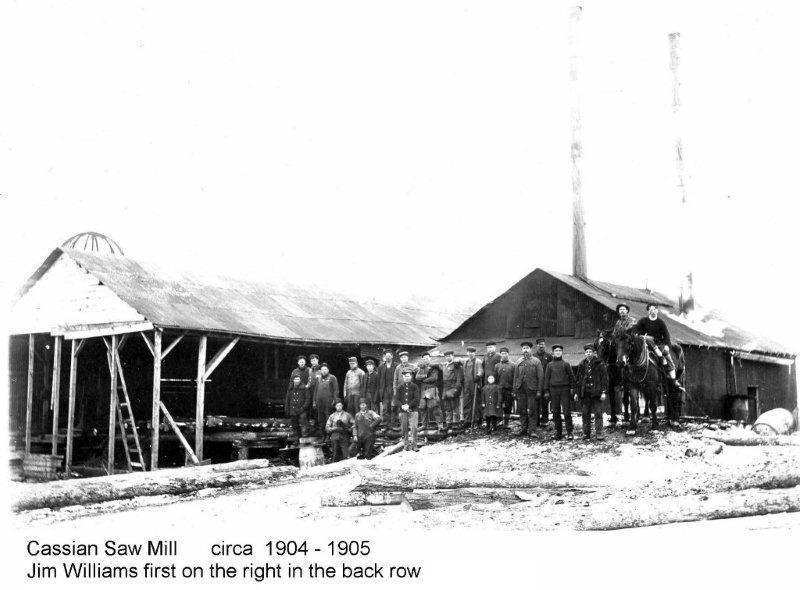
This mill was located in today's Town of Nokomis, previously Casanova Junction, the name changed to Cassian by 1903. Photo courtesy of Sherry Tischdendorf.. Nokomis split off from the Town of Cassian in 1948. In 1887, three villages sprang up along the Chicago, Milwaukee, St. Paul Railway in the then Woodboro Township. It included the villages of Cassian, Harshaw and Goodnow. Cassian had earlier split off from Woodboro, in 1903.
When the town was split again, Cassian ended up in the new Town of Nokomis, but Harshaw and Goodnow remained in Cassian Township, to confuse matters. This mill was located just East of the intersection of todays Hwy L and Rocky Rd in, Sec 14, T.36N.-R6E.
The above Railway is now on the Southern part of the Bearskin Trail System.
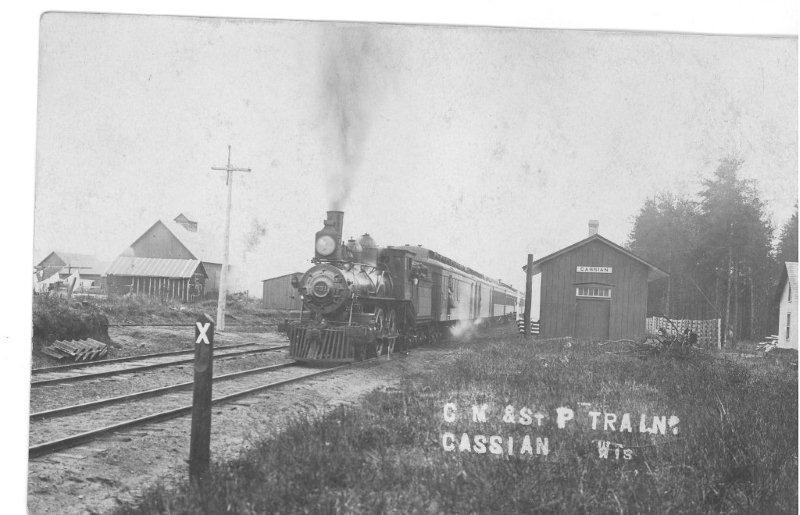
The Cassian Depot, about 1905, along the Chicago, Milwaukee, St. Paul Railway. This was situated along todays Hwy L and Rocky Rd, in Sec 14, T.36N.-R6E..
The depot is on the right and the Williams Farm on the left. A railway spur went south from here to the former Village of Braxton, near the northern end of todays Lake Nokomis. and Hwy L. Another spur went north east to Goodyear Lake, North of today's highway K. Most of these railway beds became a base for later roads, some in existance today. The mainline Chicago, Milwaukee, St. Paul, RR, is now the Bearskin Train, administered as a linial state park, by the DNR.
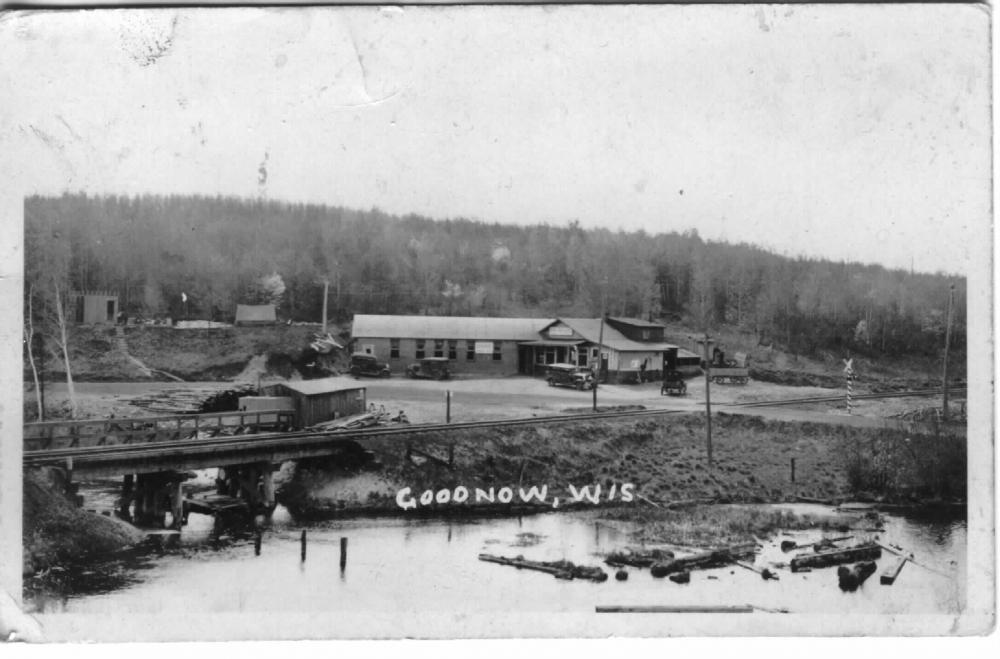
Goodnow ca. 1920. Goodnow was reportedly named after Count Goodnow of Tomahawk, He engaged in logging operations thruout the area about 1900 . Another theory is that the town was named after a Supt. Goodenow, who was a supervisor for the A.L. Langdon Co. from Minneapolis. They were the contractors building the railway in 1877. A sawmill was built on the Bearskin Creek, where the Chicago, Milwaukee and St. Paul Railway crossed. The building in foreground was at various times, a dance hall, tavern, and store. It burned in 1969, when owned by Frank Erlitz. The original rail depot, water tower and siding was located just to the East (L) of this photo, on todays Pinewood Country Club.
A small portion of this building still remains along todays Bearskin Trail where it crosses today's Lakewood Road. This road, was originally State Hwy 10, from 1915-1925, when it became Federal Hwy 51. Hwy 51 was re-routed in 1936 about 1 mile to the West, along todays Hwy 51/39. It wasn't paved from Harshaw to Minocqua until 1940, due to lack of funds during the depression in the 1930's. The re-routed highway cut off 11 miles between Tomahawk and Minocqua, and many dangerous curves, according to newspaper articles at the time.
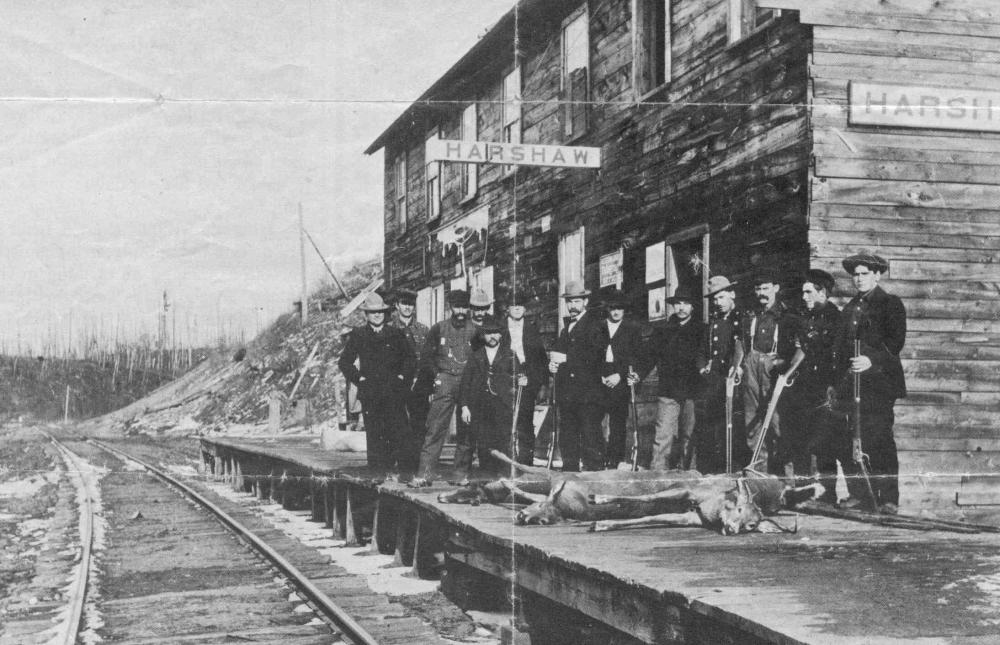
This was the first Harshaw Depot and Hotel built about 1888 on the Chicago, Milwaukee, St. Paul Railway. A group of deer hunters posed after a hunt ca. 1900. The depot appears to have been built with used lumber, common at that time. The picture faces North along todays Harshaw Road and Bearskin Trail. There was a shingle mill operating , across the tracks,on the West side of the Bearskin Creek. It's not known when this building was replaced with a smaller one. The shingle mill is thought to have shut down about 1909. There was a railway spur built by John O'Day that went south from here to Camp Ruth, a logging camp, that was located near todays Hwy K and Rice Creek. The RR spur went alongside O'Day Lake, according to town records.
When the rails were taken up and the spur abandoned in 1909, part of it became todays Harshaw Rd. by 1911, according to old Cassian Road records. This allowed Harshaw residents a quicker route to Woodboro and Rhinelander. The route to Tomahawk then passed along today's Church Rd, to Lakewood Rd., to Fernwood Rd. , to Mitchell Rd, to McKay Rd and South, according to early plat books. These were basically wagon roads..
Because there was no easy way to get early automobiles north to Hazelhurst, or Minocqua until about 1915, newspapers reported that cars would be driven on the RR ties very slowly from Harshaw to Minocqua. This took about 3 hours. Drivers had to study the train schedules carefully.
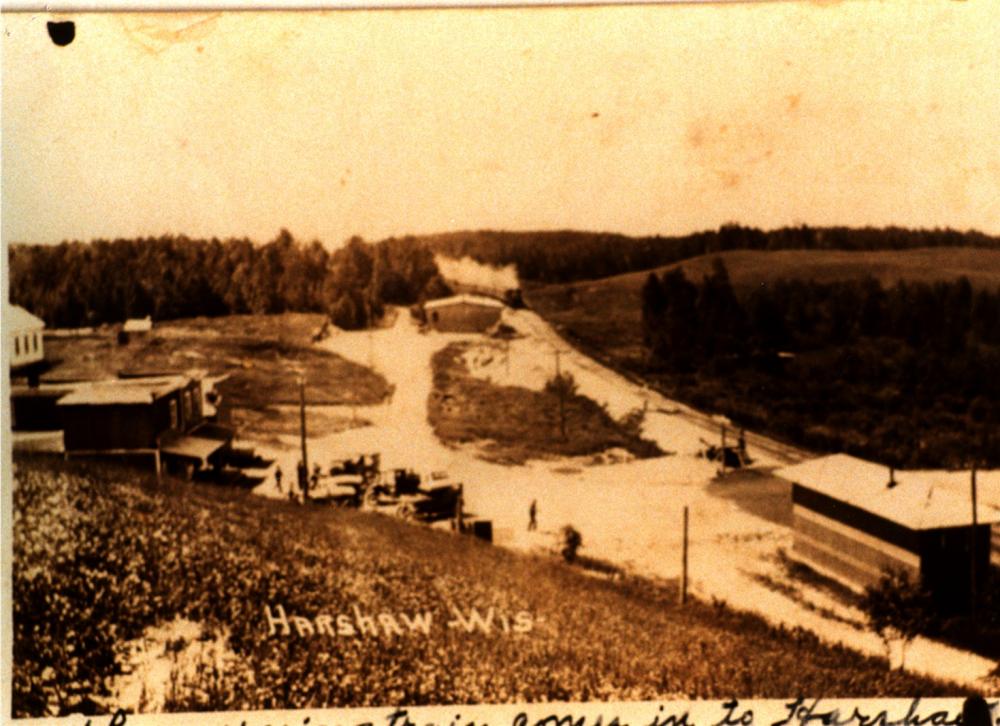
Copy of a post card depicting Harshaw in the early 1920's. A steam locomotove can be seen approching the town from the South toward the potato warehouse, thought to be owned by Leonard Hamilton along side the Chicago, Milwaukee, St. Paul Railway, at that time. The school house and General Store are visiable on the left, and RR depot on right. Notice the lack of trees at the time.
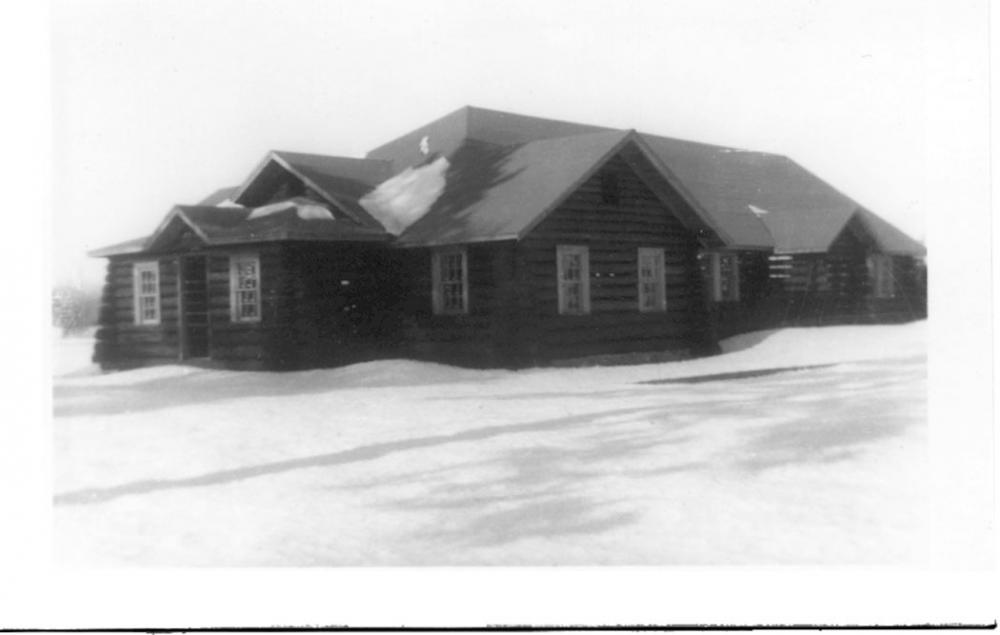
The Harshaw Womans Club and Community Center was built in 1937 on the East side ot the then newly constructed Hwy 51, just North of Rocky Run Rd.. Harry Klippel had just built a service station across the Hwy, and donated the land. The Louise Arneson Federated Womans Club, of about 18 members deemed the structure to be used for "recreational, religious and educational groups- for the up- building of the community"
Club members purchased the logs and roof boards, but other lumber to be sawed was donated. The majority of the labor was donated as well, by members and their husbands. It took several years to complete, but served the community well, for numerous functions. By the 1980s, with lack of use, the building deteriorated,and was burned down in training sessions but area fire departments in 1997.
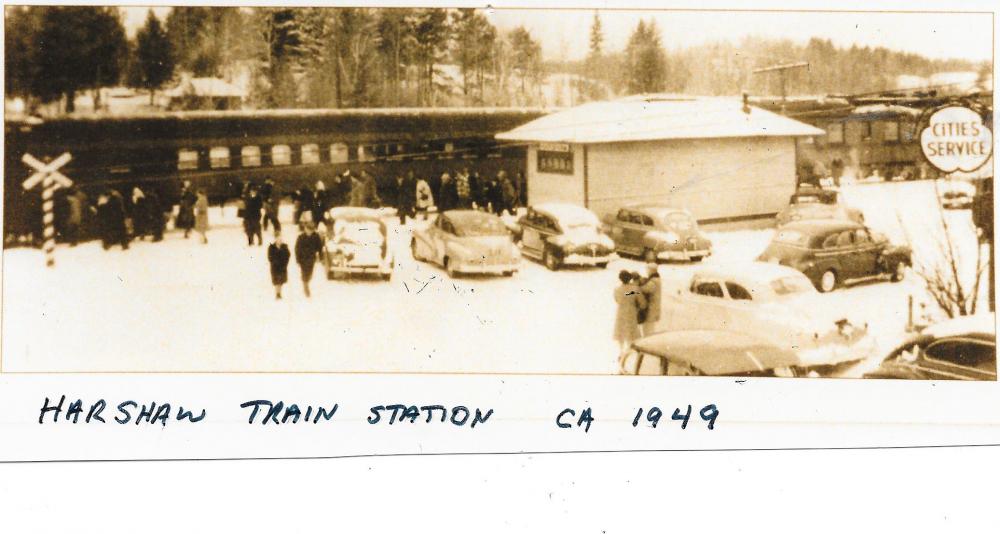
The Milwaukee Road, Harshaw Train Depot as it was called about 1949. It was a busy transfer site, for folks wanting to get to Rhinelander. Passenger rail service was discontinued in 1956, and freight service about 10 years later. The depot was torn down in 1969, and the rails taken up in 1973. The RR right-of-way was converted to the Bearskin Trail in the late 1980's and is today enjoyed by hikers and bikers in summer, and snowmobiles in winter.
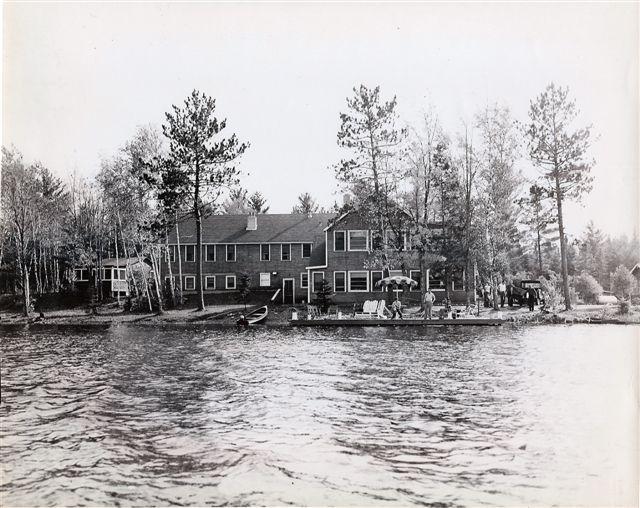
The Hideaway Lodge as it appeared in the late 1940's shortly after it was completed by Glenn G Fisher Jr. of Chicago The lodge, while no longer open as a restruant and bar, is located on Musky Lake, off of Sand Lake Road, near the Lake Tomahawk town line. The resort was first named Fisher's Resort..
Glenn and his father, had started construction before WWII, using lumber logged from the site. During the war he served as a bomber pilot and completed construction on the resort after the war. Besides the lodge there were 6 or 7 cottages, Four remain today as rentals..
Due to the fact that the Fisher Family owned an auto dealership in Chicago, they had a business relationship with the Capone Syndicate there . The Capones had a financial interest in the resort and eventially took over operation of it by the late 1940's. The facility then gained a reputation as a gangster hideout catering to unsavory characters who reportedly posted armed guards at times along Sand Lake Road.
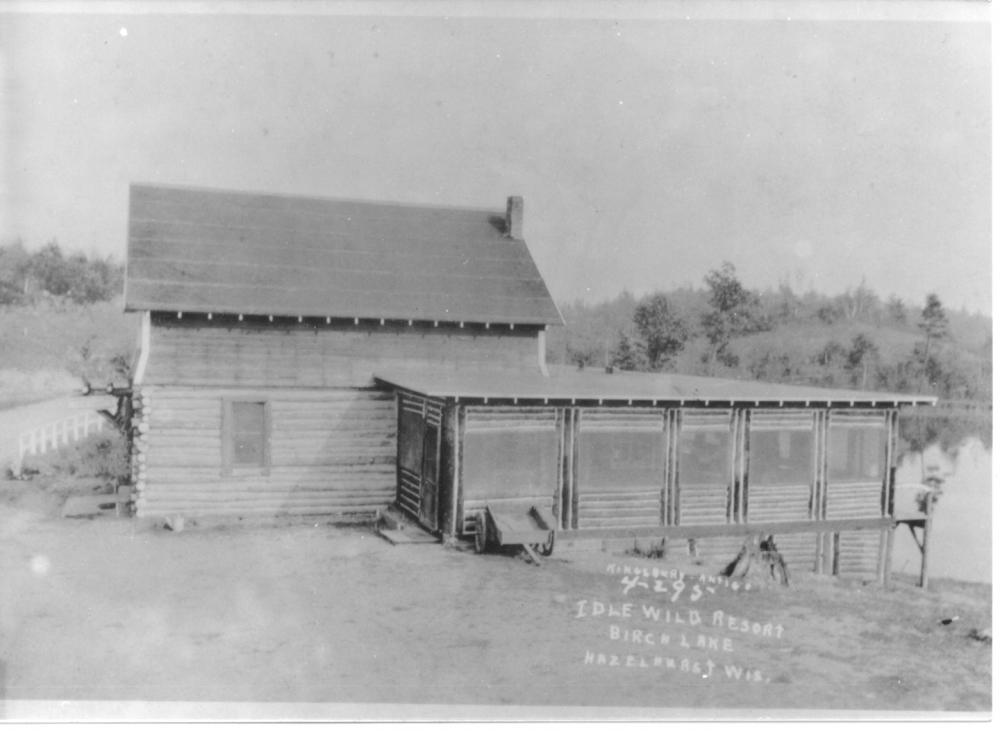
The Idlewild Resort as it appeared in 1921, shortly after construction on Birch Lake, in Harshaw. It was built by Edward C Young from Wausau on the shore of Birch Lake along then State Hwy 10. The site included 35 acres on both sides of the hwy. Two cabins can be seen standing just to the South of the building, and remain standing today.
The original structure was 24x32 feet. with a kitchen 24x52 feet according to early accounts. It was constructed of tamarack and spruce logs, which Mr. Young cut on his land. The original resort included an icehouse, and across the hwy, were located a garage, poultry yard, garden and barn, for dairy cows,.so that fresh food and milk be available for guests.
This building burned to he ground in 1926, and was rebuilt on the same site by Mr. Young in 1927 and enlarged. Newspaper reports at the time mention a wolf that the Young Family kept in a pen, as a tourist attraction. Note the lack of trees to the North along what was then also called-The Hazelhurst Road.
At the time, there one one other resort on the North end of Birch Lake, in Lake Tomahawk Township. It was built in 1916 by Mathias P. Boden, and called the Shepard Lake Resort.. It had a large 2 story Lodge, and a number of cabins, according to the 1924 History of Oneida County. It reportedly burned down in the 1940's. On a 1903 map, today's Birch Lake was shown as Artie Lake. Later it was named Shepard Lake, and in about 1920, called Birch Lake. Newspapers reported large forest fires in the area in 1917. Fires burned off what ever trees survived the logging days. Because the first trees to re-grow were the white birch, the lake at that time got it's new and present name.

The Idlewild Lodge Resort as it appeared in the late 1930's. The original structure had burned down in 1926 and was rebuilt in it's foot print, enlarged in 1927. From 1936 through 1944 the resort was operated by the LaVerne Frisque Family, and was then purchased by Fred and Lola Eisenman. In 1960 Don and Doris Jung purchased and completely restored the facility and added six cabins.
An early 1903 map shows today's Birch lake named Arte Lake, durning the logging era. A 1916 map shows it named Ruth Shepard Lake. About 1921, when the Youngs were building this resort, it was re-named Birch Lake, most likely because following a major 1917 forest fire, that had raged thru the area, the first trees to reappear were Birch. However after 90+ years, the majority of them are gone.
This Lodge also housed the Harshaw Post Office for a number of years, following a fire that burned down the Harshaw General Store on Harshaw Road, where it had been housed near the RR Depot in 1960. Patrons could drop-off and pick up mail at an outside window, near the entrance. The Post Office was moved across the road about 1980.
The Lodge was completely renovated again by Danny and Meetcho Stojsavljevic by June of 2008, when sadly, a spectacular fire burned it completely to the ground. The following year construction was begun on todays Birch Lake Bar and grill, which sits in the original footprint.
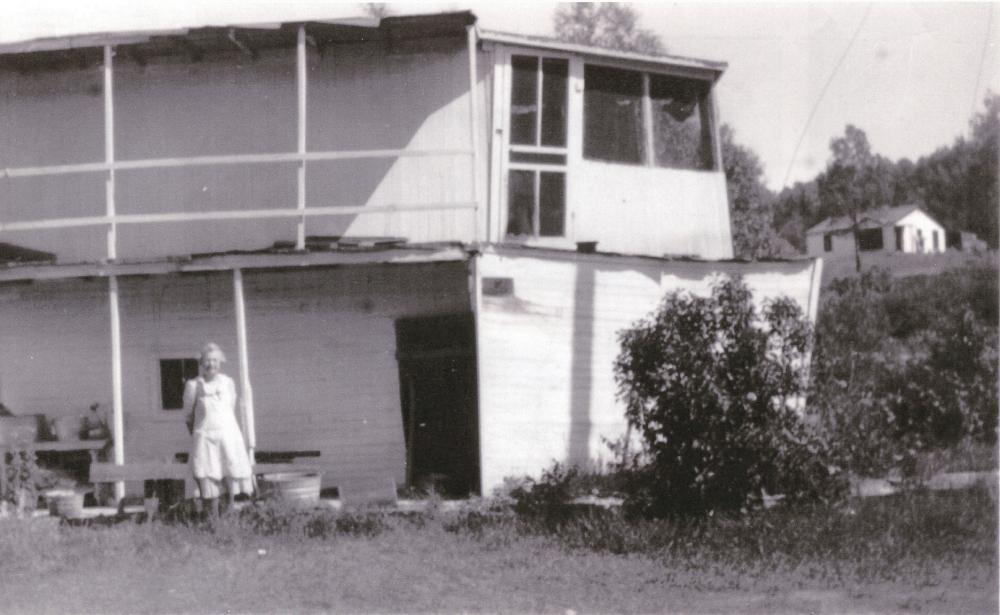
Sometimes called the Goodnow Ark, this boat-like structure once stood across the Railroad tracks from the Goodnow Store and Tavern, over the bank of the Bearskin Creek, and on the West side of today's Lakewood Road. It was somewhat of a tourist attraction.
Josie Ryan (pictured) and her husband Bill, built it about 1925. The upstairs served as living quarters, and the downstairs, at various times, a souvenior and bait shop. Reportedly, the Ryans had an organ upstairs that could be heard summer evenings, which was removed before the structure was burned and removed by Frank Erlitz, during the 1950's. Bill Ryan reportedly, liked to sit on his upper deck and watch the tourists and trains go by.
Supposedly the organ still survives in the stone Wagner House on Goodnow Rd.
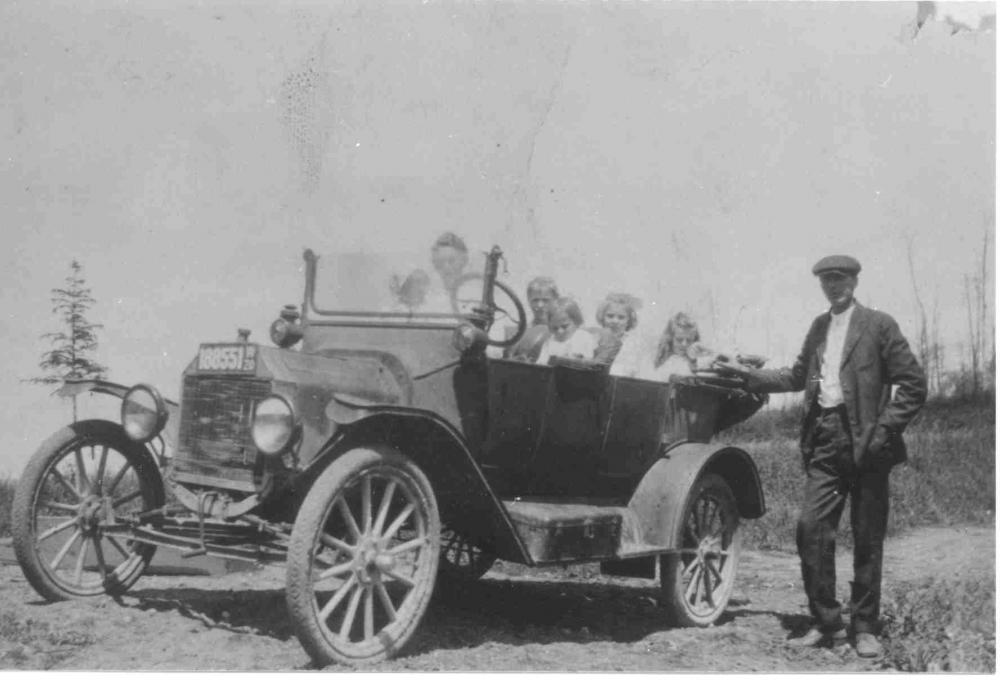
This photo was taken of the Martin Herman Family near Harshaw about 1917. The Herman Family settled initially on today's Clover Valley Rd. The original homestead built about 1916, can still be seen on the West side of the road , South of Herman's Crossing.
They reportedly shared owership of this auto, for a while, with their Webster Family neighbors, who lived just South of them on today's Grace Lane and Webster Road.
Descendants of both Famiies still live in the area. Initially these familes came to the cut-over lands, just north of Harsaw to begin farming operations. They cleared the stumps, planting crops, mainly potatos, which could be shipped by rail to markets in Milwauee and Chicago. Remnants of potato warehouses can still be seen through-out the town.
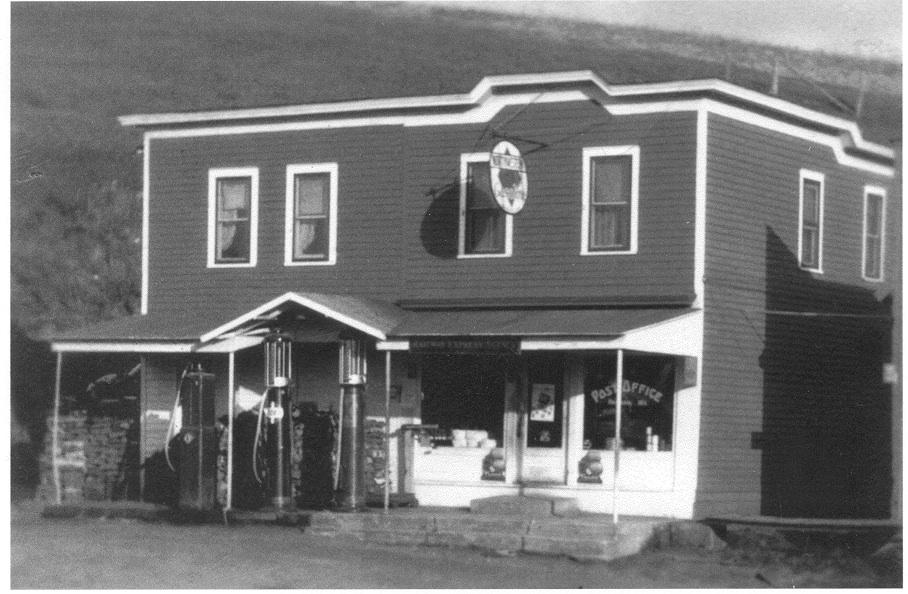
The Harshaw General Store, officially called the Harshaw Mercantile Co, as it appeared about 1930.
For almost 60 years this building served as the focal point and hub of the the small vibrant village of Harshaw. From groceries, hardware, farm equipment, ice, kerosene, seed, almost anything the local residents needed were available. It also served a waiting area for the near-by Railway Depot, as well as the US Post Office, among other things.
It's thought that early settler, and farmer, Barzy Winnie first established the business in the early 1900's. He either built or moved part of the building there, and then added on to it before 1920, adding the gasoline and kerosene pumps.. Barzy and his family likely ran the business until 1918/19, and then records show Elmer Webster ran it briefly until the Spring of 1920, when William F Stock took over for the next 5 years. From 1925 thru 1927, Archie Winnie, L.W. Layton, and Gordon Synott are known to operated the store, until Harrison McNown from Mauston arrived with his new wife, Ester prior to the depression era. They and their family ran the business from 1927 until retiring in 1959. It was then leased to Fred Peters, for 1 year, and later to Forest Batte in 1960. Sadly, this landmark building burned to the ground, on May 30th, Memorial Day, 1962. Today it's difficult to see, that the village of Harshaw had existed here along the rail road tracks at all.
In 1995, after her husband Harrison had passed away Ester McNown detailed from her journals the fascinating saga of surviving many years at the Harshaw General Store, and of the colorful local folks frequenting it ,as well as the tourists and travelers passing thru.
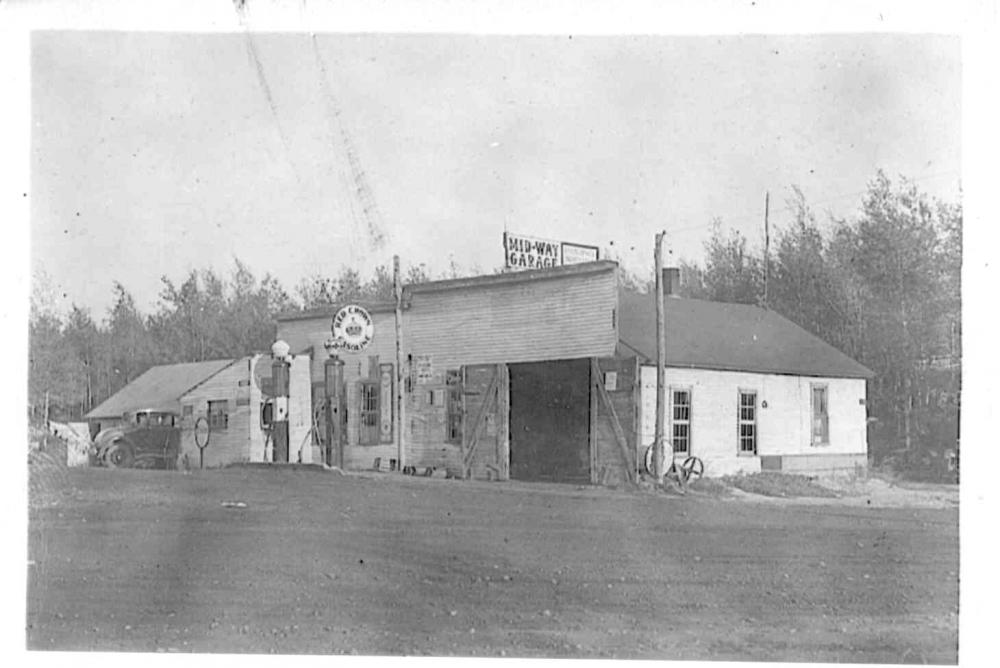
About 1930, Elmer Titus opened up the Midway Garage, which was located at the intersection of todays Lakewood Rd, and Hwy K. It was midway between Tomahawk and Minocqua, and was a busy place during the summer tourist season along the then Hwy 51.
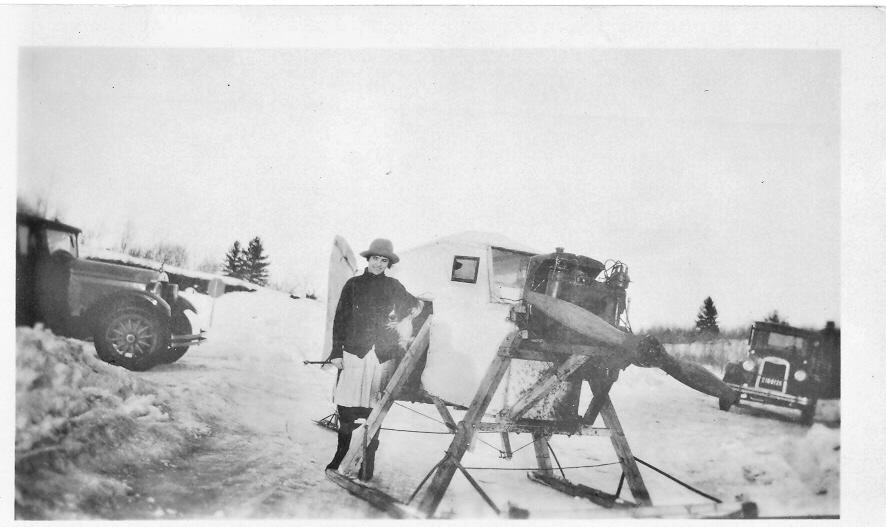
Elmer Titus's homemade snow mobile, with wife Sylvia about 1928. The machine was propeller driven, and sported an airplane engine. In 1920, the couple moved from Iowa, to homestead 40 Acres in Cassian, South of Swamp Lake Road. They later built the First Midway Garage in 1932, at the intersection of todays Hwy K and Lakewood Road, originally Hwy 51 and 14 . When Hwy 51 was re-routed in 1936/7, they built the second one on the site of today's Northwoods Store, at the intersection of the new Hwy 51 and and today's Hwy K. Notice the lack of trees along Hwy 14, (K) in Harsahw at that time.
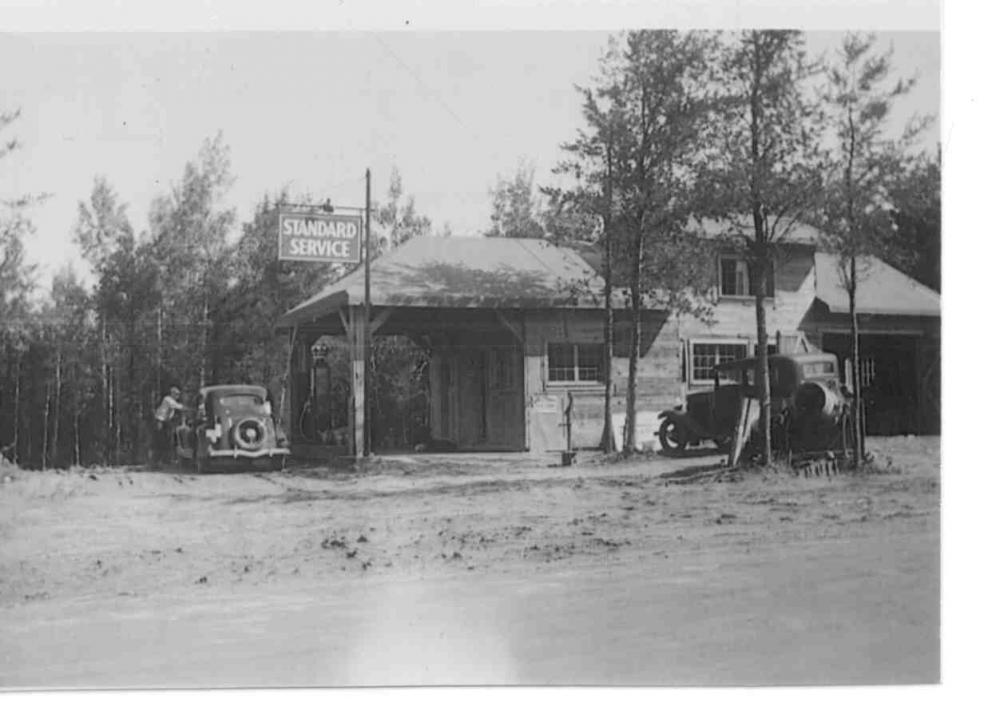
A photo of the new Midway Garage, built by Elmer Titus about 1936, when todays Hwy 51 was re-routed to the West of the old hwy., today's Lakewood Road. He rebuilt to be on the busy Hwy. 51 again, which was not paved at this point until 1940. This structure stood where today's Northwoods Store sits. Living quarters were built above the garage, gas station and store. It also served as the areas tourist information center. Elmer's wife Sylvia helped him run the business, that also included 5 pr 6 tourist cabins. One of these cabins still exists across Hwy K, to the South on the hill.
Elmer also served as the towns constable at this time, and helped many people keep their cars running during the depression years, helping everyone he could according to many accounts.
This building burned down about 1960, after it was purchased by Josephine Bach. It was re-built and purchased by the Duchow Family in 1965, who remodeled and ran it until the LaMont Henry Family purchased it. They are running it today.
Another business near that intersection, was the Hitching Post Bar, owned by Eleven Brown, and South on Hwy 51, the Whispering Pines store and gas station run by Erv Lee.

Photo of original Cassian Depot, along the Chicago, Milwaukee, St. Paul Railway in 1905, shortly after Cassian was split away from the Town of Woodboro. Prior to this time the station had been known as Cassonova's Junction, the name being shortened in 1903, to Cassian when the Jensen's store and Post Office was built nearby. There is no other town by that name.

This picture of the Rest-A-While Resort was taken in the 1930's. It stood on the N. E. shore of Big Bearskin Lake until burning down in the mid 1970's This was once probably one of the more elaborate Resort complexes in the Cassian area. It was located on today's E. Bearskin Road, West of Lakewood Road.
Bert Meyers ran the business until about 1956, when the main house burned.
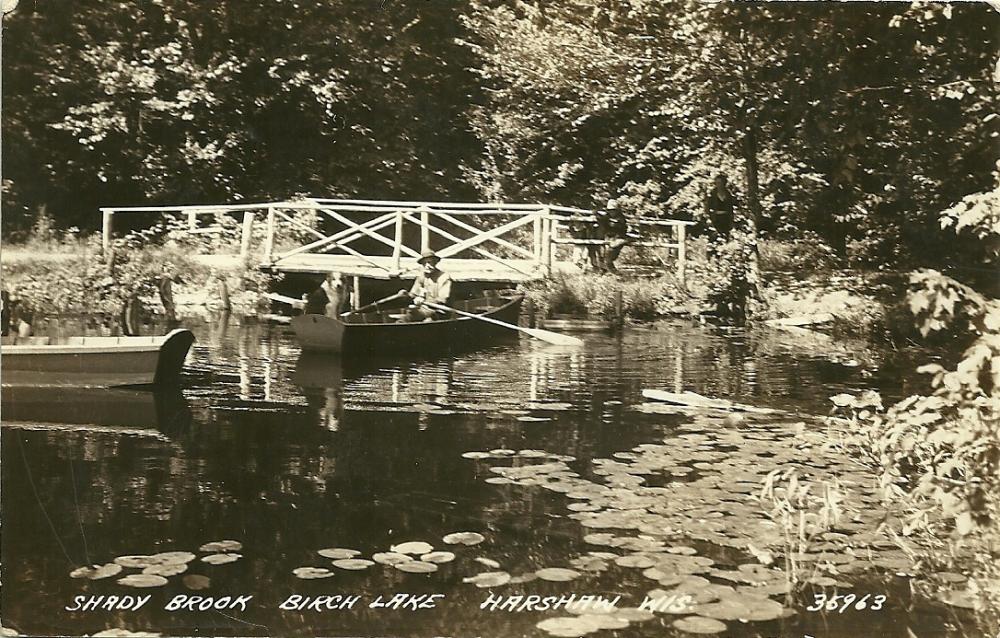
This scenic picture was taken in the 1940's at Birch Lake's outlet where it flows under today's Bertland Road towards Big Bearskin Lake.. The Shady Rest Resort was then located at the Lake's outlet there and some resort of buildings remain today as privately owned homes or cabins.
Reportedly, during the logging era, a corduroy road was laid across what had been called Musky Creek, and later the bridge built about 1915 to provide access to another resort called the Shepard Lake Lodge, on the north end of Birch Lake, then named Shepard Lake. When culverts were installed in the 1960's some of the old corduroy logs had to dug out.. Just to the west of the bridge was a dam that had been constructed in the creek, during the logging days to raise the lake level high enough to float cut logs out of Birch Lake. The dam was blasted open allowing the mostly white pine logs to move on to Big Bearskin Lake, and down the Bearskin Creek to Mills south of there.
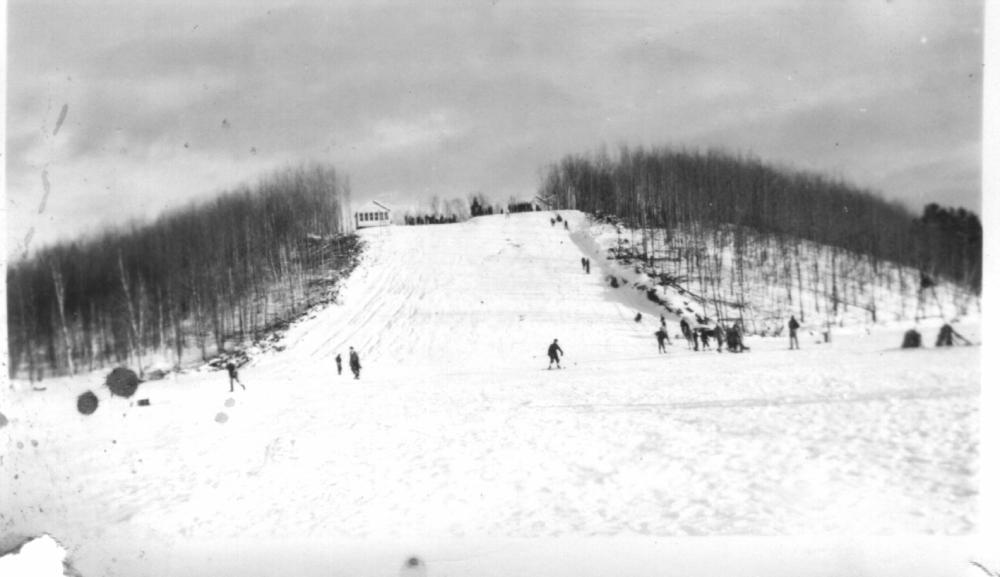
This ski hill was constructed by either the Brown or Ellitz family in the late 1940's. Tickets for the tow rope were sold at the Goodnow Store and Tavern. The ski slope terminated onto Big Bearskin Lake. Skiers held onto two rope to return back up the hill. The system reportedly was powered by an old Buick car engine until the early 1950's when the ski hill was shut down by Frank Erlize who then owned and ran the Goodnow Store and Tavern.
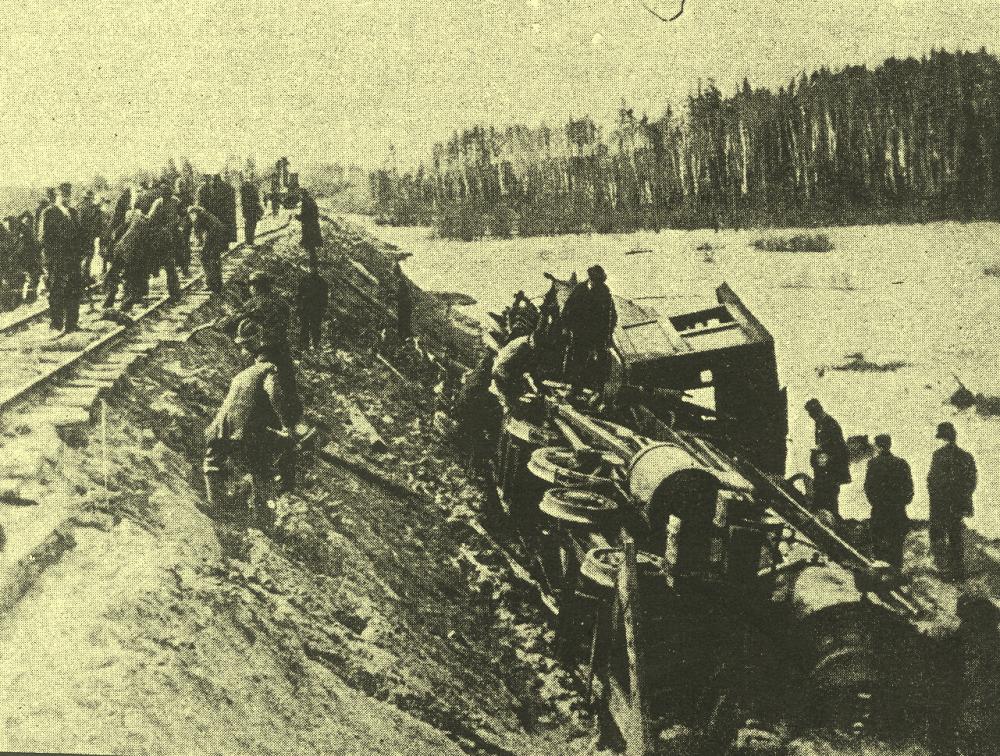
Photo of a train derailment, along the Bearskin Creek, just north of Harshaw, about 1912. The Chicago, Milwaukee, St.Paul Railway, had considerable difficulty maintaining the tracks wherever deep marshy areas had to be filled. The fill would constantly keep sinking making the line unstable. Reportedly, not only this locomotive, but a crane and several tender cars also slowly sank into the muck, and remain there today.
Eventually much of the fill was removed, and a long curved trestle constructed on deep pilings, which today is part of the Bearskin Trail system. By 1973 all the rails had been removed.after 86 years of hauling logs, lumber, freight, and countless travelers throughout the area.
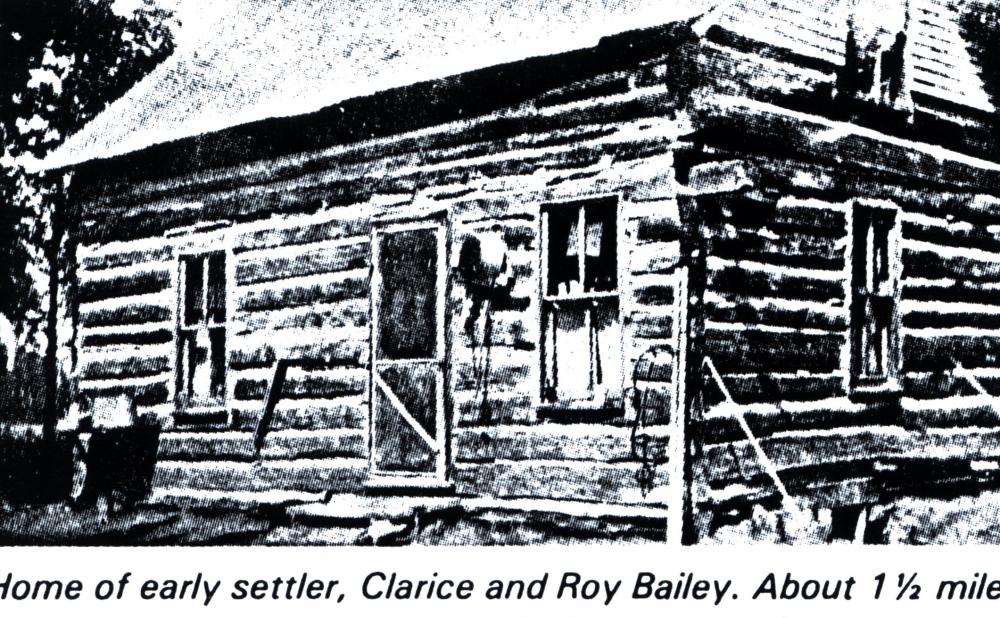
A picture of the Bailey Family log cabin. Roy and his wife Clarice moved to Harshaw in 19i8. Roy died in 1930 and is buried at the Union Grove Cemetery,then called the Harshaw-Goodnow Cemetery. This cabin was located on todays Clover Valley Rd.

It is not known exactly where this first Harshaw Post Office General Store was located circa 1905-10. Early records indicated, it may have stood on today's Lakewood Rd where it intersected with the Chicago Milwaukee St Paul RR just North of Meadowlark Rd. Nearby is the foundation of a later store there on the West side of the road. It was called the West Store in records.
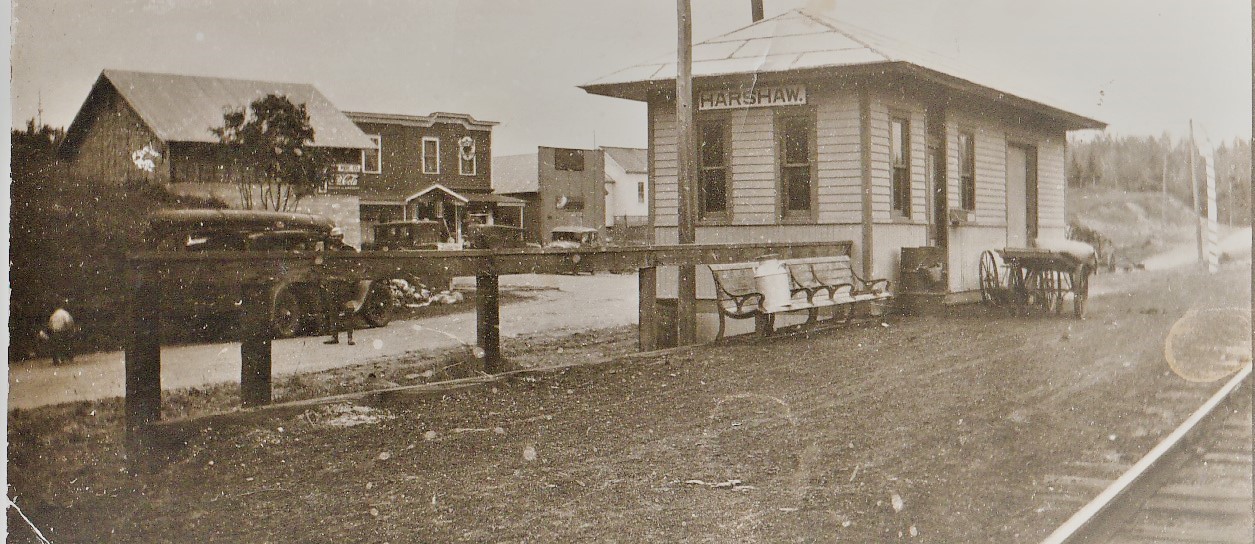
This photo is of Harshaw Village looking south, as it looked in the 1920s. To the left is the ice house, the McNown General store, blacksmith shop, school house, and Winnie Farm. To the right is the RR Depot. Today on Harshaw Rd, just south of Church Rd sits a mobile home where the general store stood. It also housed the Post office and gas station at times. Most of the buildings burned by the 1950-60s.
